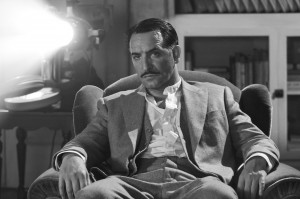‘The Artist’: Beautiful Quietude in Glorious Black And White
If there’s one thing plaguing movies today, it’s an overabundance of sound. Yet, amid a cacophony of clanking competition, a production like The Artist rises above it all by embracing the timeless philosophy that silence is golden.
In 1927 Hollywood, Kinograph Studios has an endless string of silent films at the ready thanks to the magnetism and talent of leading man George Valentin (Jean Dujardin), who captivates crowds of all ages accompanied onscreen and off with the help of his faithful canine companion, Jack (Uggie). An encounter with an autograph hound and aspiring actress named Peppy Miller (Bérénice Bejo) causes quite a stir for the studio’s publicity, but that’s the least of Valentin’s problems. The newest thing to hit theaters is talkies, and the head of the studio (John Goodman) is ready to hop on the bandwagon. Unwilling to make the jump to movies with sound, his top actor chooses to strike out on his own and produce his own line of silent films. But, after pouring all his funds into the venture, Valentin comes to the harsh reality that there’s no longer a place in Tinseltown, unless you’re willing to make your voice heard in the newest way.
With his dapper looks, pencil mustache and cavalier personality, French actor Dujardin channels the spirit of bygone Golden Age movie stars, such as Clark Gable and William Powell, with oozing debonair to spare. The name of his character naturally refers to “The Sheik” lothario Rudolph Valentino, whose — all too early — death spared him from making the transition to the world of sound. Likewise, Bejo, maintains a mischievous crooked smile and a doe-eyed innocence all at once, possessing the kind of old-world charm seen in early star Clara Bow, who had her own problems with celebrity despite enormous popularity. Fortunately Peppy takes her ascension to stardom with a grain of salt, and, as Valentin’s biggest fan, never forgets who helped her with her big break.
Such loyalty is present in the fading actor’s personal valet (James Cromwell) and his furry cohort, but hardly anyone else. Goodman, chomping on a cigar like Bugs Bunny on a carrot, looks the part of a trend-following studio boss like Louis B. Mayer, Jack Warner or Darryl F. Zanuck — the one who started the industry down the path of sound — while Missi Pyle sports the platinum blonde locks of Jean Harlow as his favorite actress, who relishes the chance to destroy Valentin. Penelope Ann Miller goes dowdy as Valentin’s lonesome wife, who eventually leaves him as his career nears ruination, but not before demanding that he answer the question on everyone’s mind: “Why do you refuse to talk?”
Singin’ in the Rain already gave us a glance at the major shift that occurred in Hollywood once Al Jolson blasted through the speakers during the initial screening of The Jazz Singer. What the classic movie didn’t give us was the story from the perspective of those in the dying art form. By giving us a largely silent film about silent films, writer-director Michel Hazanavicius experiments with the concept of bringing back an obsolete style — attempted by Mel Brooks in the ’70s with the forgettable Silent Movie — without falling prey to the foibles found in many films made more than 80 years ago. When you have the option, instead of the obligation, of shooting in monochrome — and sticking in text cards whenever someone has something important to say — it’s easier to find a way to make everything more aesthetically pleasing overall, thanks to more advanced technology. We get a real sense of why Valentin sticks to his guns — not because of stupidity or arrogance, but a genuine belief in the artistry he has mastered and loved for years.
At one point, talking pictures must have seemed like little more than a passing craze. Of course, so did iPods, personal computers, television… Need I go on? Hazanavicius allows for audio effects to take over at certain intervals, most importantly a nightmare sequence in which Valentin can hear everything clear as a bell except for his own voice, unable to register his wail of anguish as he is rendered mute, and therefore moot, amid the array of unwelcome noises, whether it’s his dog’s barks, giggles from passing chorus girls, or even the small, yet deafening, clunk of a drinking glass being set down on a table. Otherwise, Ludovic Bource’s wonderfully bouncy score is the driving sound heard by viewers, providing an ever-present sense of purpose that not all musical themes can achieve these days.
It’s unlikely that The Artist will be the first of many silent movies to be released in coming years, but that’s part of its appeal. It’s a one-of-a-kind fusion of vintage mores and a more modern reaction to those customs that all comes together just right. Though the thought of similar films is tempting, let’s hope nobody attempts to spawn a pathetic imitation. It takes a visionary to try something new, but it takes little effort to be a copycat, and you don’t have to be able to hear yourself speak to levy such an accusation. Just something to keep in mind if and when the rip-offs come around, Monsieur Hazanavicius…
Rating: 4 out of 4 stars


